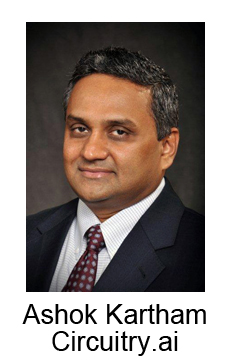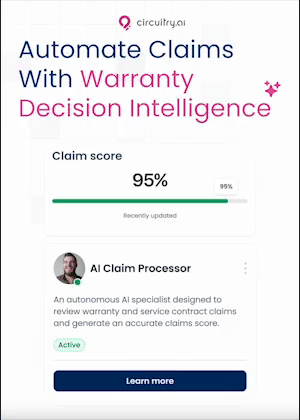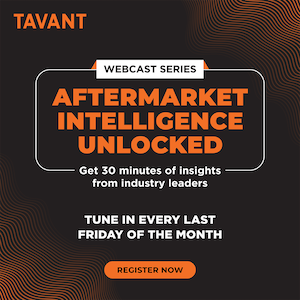Artificial Intelligence in the Warranty Lifecycle:
AI is transforming the warranty and service lifecycle, and longtime industry thought leaders are at the forefront. We spoke to Ashok Kartham, CEO of Circuitry.ai, and John Estrada, President of Xcelerator Group, about current implementations of AI, and future possibilities of the technology.
Artificial intelligence, or AI, models gather information and data, and use these to perform learning, reasoning, and decision-making. These models learn from vast amounts of data and experience, and become smarter over time, as they compile and adapt to new information over time.
Who better to take the helm of the implementation of AI solutions to the warranty industry than two long-time thought leaders? Just like AI, Ashok Kartham and John Estrada have gathered, processed, and analyzed many years of data and lived experience in the warranty industry, although the two thought leaders have been around for many more years than the AI solutions their companies have developed.
Industry Veterans Take on a New Challenge
Although AI is new technology, many of the thought leaders at the forefront of innovation are long-time industry veterans, including Ashok Kartham, founder and CEO of Circuitry.ai, and John Estrada, President of Xcelerator Group, and founder and CEO of Service Xcelerator of Xcelerator Group. Each man has over 20 years of experience at the C-suite level of warranty software companies at the forefront of innovation.

John Estrada co-founded ServiceBench in 2000, and served as its COO. ServiceBench made its name in the warranty industry connecting appliance manufacturers with retailers and repair services on an easy-to-use digital network. The company's platform also enabled manufacturers to sell extended warranties to customers who did not buy them at the point of sale, enabled the management of those extended warranties, and worked with TPAs to adjudicate warranty claims. In January 2008, N.E.W. acquired ServiceBench. Soon after, NEW merged with Asurion.
In his own words, Ashok Kartham "spent the last two decades building software platforms that serve warranty and service lifecycle," first as the founder of 4CS, and then as the founder of Mize.
4C Solutions, or 4CS, developed warranty and service lifecycle management software, with its pioneering warranty claims processing system called iWarranty. 4CS "was among the first, along with ServiceBench, to bring warranty management into the digital age," said Kartham. The two warranty software companies were similar, but engaged in different industries. Kartham and Estrada were first introduced to each other over two decades ago in these roles.
In September 2011, PTC acquired 4CS. Not one to ride off into the sunset, Kartham founded Mize, stylized as m-ize, in 2012, taking the name from the phrase "Mobilize to Monetize." Mize "helped manufacturers to deliver smarter and connected customer service experiences," said Kartham.

Mize started out focused on developing mobile applications for product registrations, customer care, field service, loyalty programs, service plans, and product warranty. The company expanded into cloud-based product warranty claims processing, with its Warranty Connect software, and then introduced the Service Contract Management software. Mize merged with Syncron in 2021.
Estrada joked, "I don't have enough hobbies. I enjoy working." But the truth is, after years working in consulting following the sale of ServiceBench, Estrada recognized a huge and growing gap in the warranty industry. "A lot of the systems that are out there are 20, 25 years old," Estrada said. "They were built on much older technology, they're much harder to maintain. They don't take advantage of AI and newer technologies. In some cases, not even smartphones."
"I think that the market is primed for new opportunities," Estrada said, "and continues to grow. Products continue to break."
Warranty and Service Lifecycle Products for the Age of AI
Kartham noted that over the last 20 years, we've seen "three major shifts in technology" in the warranty industry, "first, to the web, and then to the mobile and the cloud side, and now to AI."
"I feel like we've been very lucky, living through this period," Kartham said. "Once we started the previous companies, it's still very exciting to say, how do we leverage this latest technology, to apply to the domain in the industry we know well?" He continued, "We feel like we can bring that combination of the business understanding and technology together. Personally, I continue to see huge potential, in terms of the market, and the value we can deliver to our customers."
Kartham loves the warranty industry too much not to remain at the helm of technological innovation. "It's always exciting to do this," Kartham said, "apply the technology, continue to see the changes we are bringing to our customers, the transformation that we can enable, and things like that. That continues to motivate me, and drive me to pursue this."
Estrada concurred. "I love going from nothing to something, to really provide benefit," Estrada said. "That's what we're trying to do with Service Xcelerator."
Kartham founded Circuitry.ai in 2023. Soon after, Circuitry.ai, like Mize and 4CS before it, became a sponsor of Warranty Week. Circuitry.ai's goal is to integrate AI into every decision across the service lifecycle. Circuitry.ai's Service AI workers are trained on comprehensive data to provide expert answers, parts recommendations, and make intelligent claims and service decisions.
Current clients of Circuitry.ai include construction equipment manufacturer Takeuchi US, which uses Circuitry's Service AI Advisor on to answer service questions asked by clients on its website, as well as queries made by service technicians. Another client is Hendrick Automotive Group, which uses Circuitry's AI solutions to automate and optimize claims processing for extended warranties and service contracts.
"Today, at Circuitry," Kartham said, "I'm focused on applying AI to transform warranty decision making, improving warranty outcomes and quality. To do this, especially in partnership with Service Xcelerator and Xcelerator Group, we feel like we can bring these combined solutions that takes these companies to the AI age."
Estrada co-founded Xcelerator Group in 2023, along with Natalie Camarata and Rob Baily from ServiceBench, and Angie Breedlove from Whirlpool and Lowe's. Xcelerator engages in business consulting and custom software development, and its Service Xcelerator platform manages claims administration and field service dispatch, and utilizes AI to provide predictive and descriptive analytics.
Clients of Xcelerator include National Head Start Association (NHSA), a tier-1 auto supplier and autonomous vehicle supplier.
Making Sense of Unstructured Data
Kartham and Estrada agreed that these new ventures were natural evolutions from their previous companies. While they made great strides in the industry, they also recognized some big gaps and room for growth. As AI has evolved, both Estrada and Kartham saw opportunities for the new technology to once again revolutionize the warranty and service lifecycle.
Kartham and Estrada were uniquely poised as industry veterans. "We can leverage our previous experiences," said Kartham. "We know the data we were collecting and storing and keeping. Now, if we train the AI on all that unique data, it can provide better decisions. Others don't understand this complexity of warranty data, which we have been helping companies to create and digitize" for many years.
Kartham saw firsthand the sheer volume of warranty data being collected, and the capabilities of the traditional systems. "If we take the previous systems," Kartham said, "they were good at collecting data. Prior to that, people were probably using lot of disconnected processes, including paper, exchanging files, and things like that. So, the first generation," such as 4CS and ServiceBench, "made it easier for all the stakeholders to work on a connected workflow, claims capture digitally, registrations, returns, all of that. We call this more, bringing it to the digital age."
"In the second stage," he continued, "with Mize, now we have the mobile. We have moved from on-premises systems to the cloud, and that made it easier, again, to have more seamless workflows, to go upstream into service process, or downstream into supplier recovery analytics."
"But what these systems were not that great at was making good warranty decisions." Kartham continued, "Traditional systems, or even the ones that we did before, were built for data collection and processing, not for intelligent decision making." Traditional warranty systems "collect unstructured data, such as service notes, images, diagnostics, audio files, video files, things like that," Kartham explained.
"AI can understand the data, and provide insights that the current systems cannot provide," said Kartham.
One area where AI can add value is in claims processing, especially in making sense of all of that unstructured data. "In the claim process," Kartham said, "we are capturing a lot of unstructured data, which goes probably not used that much, or requires a lot of manual effort to take all that text, like in complaint calls and corrective action, or the images that we enable to be attached to the claims. People may have to personally look at it, but it's probably not used that much. Same way, if we are adding diagnostic data, IoT data, things like that, it's not humanly possible for people to review all that data, to make sense of it. So now, AI can enable that."
Estrada noted that using AI, Xcelerator is able to "monitor all the conversation between an independent service provider and the end customer." "Without AI," Estrada said, "you may have been able to gather that data, but you couldn't afford to have somebody look at it. And a lot of it's very innocuous: 'Hey, we're going to come out tomorrow.' 'Great. I'll see you tomorrow.' That's not something anyone needs to do something with. You don't want to the spend resources for somebody to read that and mark that it's not a problem."
With AI, you can look at every conversation, said Estrada, and "do that unbelievably cost effectively. We can record that, and probably no one's ever going to look at it. But then, when you find the issues of: 'What do you mean you're rescheduling? This is the fourth time. I really need to get my refrigerator, or my air conditioner, or whatever, repaired.'"
AI would immediately flag that conversation for investigation. "Then," said Estrada, "those issues can either be resolved by the AI, or at least bubbled up, so they become solved issues before they become major problems, where you have to swap out products, or that sort of thing. I think that's a big differentiator from what previous systems are capable of doing."
Furthermore, Kartham noted, "Instead of using static rules, which need to be continuously updated as things change, what AI can bring is what we call service decision intelligence. We're learning from the claims history."
Teaming Up to Integrate and Implement AI in the Warranty Service Lifecycle
Similar to the early 2000s, Estrada and Kartham once again find themselves at the forefront of the cutting edge of warranty systems management, this time at the helms of AI solutions companies with complementary capabilities.
Estrada told us, "We're rolling out a next generation service management platform, which handles the dispatching of service, gives you AI-powered insight to what's happening between the service providers and consumer, and does claims processing. In every one of the steps, we're integrating AI to automate and to improve the processes."
"At Circuitry," Kartham said, "we decided not to focus on the transactional workflow, as John is providing with the service management system. Instead, we wanted to really focus on how we can apply AI to improve the quality, consistency, and velocity of conditions that are involved in the warranty lifecycle, whether it's repair, claims decisions, parts decisions, or proprietary decisions."
"We are investing developing the good AI models and algorithms to help with this process," said Kartham, "that is making sure that experience is great for the front-end facing. And then, how do we bring those systems to the next generation? We are bringing both the front-end transactional side and the decision intelligence with Circuitry.ai. Together with Xcelerator, it will be the most intelligent and best experience that can be delivered to the customers."
The goal, said Estrada, is "to allow our customers, whether it's an OEM, or an extended warranty company, or a retailer, to be able to provide much better service, at a much lower cost point. So, you can get the best of both worlds. You need to improve your service. I mean, everyone wants to have good service, but you need to do that cost effectively, and continue to improve, and make the customers feel happy, so that they'll buy more of your products."
It sounds simple, but that's a vital maxim in this industry. When a customer needs to use their warranty, something has gone wrong. To transform that pain point into a positive experience is a key driver of brand loyalty for customers, and represents a real opportunity for warranty to boost revenue in the long term. To do that while still saving money is a dream.
"As a consumer," Estrada said, "I want to be able to deal with the warranty provider, the manufacturer, whomever, in the way that I want to, and have my time have some value. It's very frustrating to have to come in, give some automated system a bunch of information, and eventually, you get to a human, and you have to give all that same information again." Estrada continued, "Having that seamless ability to be able to access, in the way you as the customer want, any of the warranty systems, and for the AI to unite them all together, is key, and one of the things that we're looking to do as we move forward."
Kartham agreed, and stated, "At the core, I believe great customer experience means easy to work with, resolving issues quickly, and delivering more value from the product, over its lifecycle, to the end-customers. We think AI enables all of this."
"Customer experience is not just about claims, even though warranty is focused on that. It's about reducing the need for claims," said Kartham. "One of the things AI can enable is, how do we fix it right the first time? How do we enable technicians to have the right procedure, right parts, to fix it, so there are no repeat failures, and it's done as cost effectively as possible?"
"If AI can improve even the speed of claims payment, we think the dealers would be happier, their service to customers will be better, and preventing defects will help improve the value of the products. On every aspect of the customer experience, whether it's being easy to do business with, faster resolution, or higher product quality, I think AI can help a lot, compared to the existing systems that may have focused on maybe, a reactive way to claims only, or some other aspects of that."
Furthermore, Kartham noted that there are three key areas where AI solutions "can help improve the customer experience, and lower cost at the same time":
"One is, self-service and contact centers powered by AI. If it's questions related to service, parts, and warranty, either from end-customers or dealers, the AI-powered assistance, which we call AI Advisors, can answer these questions instantly, instead of people spending a lot of time looking up these data in different sources to do it. So, that reduces the wait times, which improves the customer satisfaction and experience.
The second is, OEMs are looking for efficiencies and productivity from the automation that can be enabled by AI. That's what we're doing, applying AI to, whether it's analyzing historic claims data, streamlining approvals, eliminating inconsistencies, or detecting fraud. How do we reduce the cost of claim processing, as well as the cost of the claims themselves? We are always looking at how companies can reduce the warranty costs, and be profitable to do it.
Then, finally, I would say this: A lot of data has been collected. As we mentioned, it hasn't been used as much, to get the value out of it. We think the AI can use that data to provide more predictive insights, and can provide a predictability to emerging issues. Companies can improve the product quality, which again, leads to lower costs for the manufacturers, as well as a better product experience and value for the end-customers. That's where we think AI takes it much further in enhancing the customer experience, as well as improve productivity, the product quality, and the outcomes for all stakeholders."
Navigating the Risks of AI
Of course, all new technology comes with its sceptics and new risks. With generative AI, especially the high-profile chatbots and image generators, there's a risk of hallucinations, or the possibility for human manipulation.
Kartham aptly noted that general-purpose chatbots and image generators "are generic AI chatbots that are serving all the consumers, across all the areas. They are mostly trained on the whole knowledge of the web, and things like that." Those are open AI models, while Circuitry and Xcelerator use their own closed, secure, and proprietary AI models.
Circuitry.ai's systems are homegrown and much more refined and fine-tuned in their specific applications and solutions. Kartham told us:
"For us, the first thing is, we are vertical enterprise grade AI. We are mainly focused on a particular domain in the industry. So, one thing we are doing is, we are training our AI on the claims history, the service content that manufacturers have created. We are not using the generic knowledge, or YouTube channels, or things like that, for service. So, part of our model is, focus on that trusted, curated data.
Because for manufacturers, the accuracy, the trust, all of that matters a lot more than a consumer chatbot AI type of thing. So, we are focusing on, how do we develop this responsibly? We apply a rigorous training, testing, monitoring, with clear guidelines on it. The guidelines could be, we won't answer any question unless we can support it with the real data as a reference, either service data or warranty data to do it.
We are making our decisions or conversations explainable, so the manufacturer can say, explain why this answer is provided. What is the source of data? What are the steps it went through? Which is a big thing for AI. Instead of looking at it as a block box, look at it as an explainable, auditable model. I think that will help improve the trust and the confidence in these systems.
With AI, we're not trying to replace the current workflow or core systems people are using. We are augmenting or automating those systems with it, so they are using them side by side. There is also a human in the loop. We are not saying, everything from day one is automated. All these steps together will ensure we provide that accuracy, trust, data privacy, and governance that our target customers are looking for."
Estrada noted, "We recognize that we need to make sure we have systems in place to monitor answers and responsibilities, and to build things in over time. We're looking at using AI to predict things, but then have a human being make the final decision. Over time, we gradually can open it up to do more."
At the same time, both companies recognize the importance of protecting customers' personal identifying information (PII), and manufacturers' intellectual property and proprietary technology. Kartham said, "We are building our AI with enterprise grade security, privacy, and governance, from the ground up. We always segregate the customer data. We are not in the data business. We are not providing any of our data to train any other models than what serves that customer."
Looking to the Future
Overall, Estrada said, "The goal is to allow companies to provide better service at a lower cost point. And I think with AI properly used, and made easy for the customer, we could really make a difference with that. Ashok and I, our two companies working together, can really be at the forefront of bringing that to a wide range of industries."
And the two men have their eyes on the future. "We expect several breakthroughs over the next five or ten years," said Kartham, "that are going to reshape the warranty, transform the warranty by AI."
In the future, said Kartham, "People will be able to interact with AI naturally. If you think of that as a conversational AI, it will allow, for example, service techs to narrate the repairs in real time, using their voice. Maybe even in a different language, that could be translated in real time. No more typing, and filling out forms, which I think many relate to." Kartham predicts massive improvements in productivity with the help of AI, eliminating the busywork of sorting through data to find an answer or solution.
Furthermore, said Kartham, "Vision AI is improving. In the future, people will take a picture of the failed part, and the whole claim can be generated. We can assess the damage, identify the part, and things like that. It will get to be where, the vision, just like conversational AI, can validate failures, capture the service evidence automatically." As a bonus, "There will be less chance for fraud."
Overall, said Kartham, "Connected products are amazing, and companies capture a lot of IoT data, but not many have gotten much value out of them. AI can process huge streams of data, and provide insights."
In the future, AI will not replace humans, as many fear. Instead, Kartham said, "AI will become this layer between the data and the people, analyzing, reasoning, even acting, before people get involved into this process."
Kartham and Estrada agreed that AI-powered decision making will become the industry standard. Kartham predicted, "Just as online warranty systems revolutionized how warranty is done a couple of decades ago, AI-powered decision making will be the new normal." And just as the two men were at the forefront of the evolution of warranty claims processing solutions from manual to digital, and from local to cloud, they're leading the way into this new era of AI.









